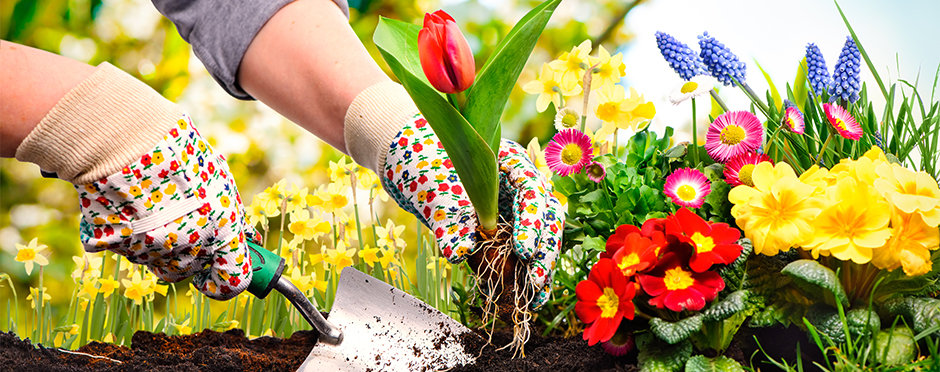
4 Tips for Protecting Your Hands When Gardening
1 CommentGardening is a hobby enjoyed by many Americans, and especially among men and women over the age of 45.2 Unfortunately, this group of people can often be limited in participation in their beloved hobby by physical and environmental factors, including osteoarthritis (OA) and environmental contaminants.
The presence of OA symptoms is more likely in this group as the prevalence of this disease increases with age. OA often affects the joints in the fingertips as well as the base of the thumb. Since this activity requires forceful and repetitive use of these joints, OA symptoms in the hand can impact one’s ability to work in the garden. Another factor that can affect safe and pain-free engagement in gardening with the hands is contaminants in soil and brush as these increase the risk of irritation or infection in the hands.
Thus, to ensure successful and enjoyable engagement in gardening for years to come it is important to protect the hands in multiple ways. Employing the four tips listed below can help accomplish this:
1. Wear Gloves
Perhaps the lowest cost and most effective means to protect hands from contaminants in the soil and potential irritation is using gloves. Gloves help defend hands from exposure to fertilizers, bacteria and fungus in the soil.1 Plus, gloves block most, if not all, sun UV radiation, helping to prevent sun damage. Although many people are aware that they need to wear sunscreen or wear a hat to protect their face from UV radiation, the hands are oftentimes neglected.1
For those with small hands who have trouble finding gardening gloves that fit, try wearing surgical gloves. Surgical gloves are available at many pharmacies and come in many sizes, fitting most people.
2. Use Gardening Tools
Hands are designed to perform the action of dozens of tools. Digging, ripping and patting are all actions required for gardening, and oftentimes gardeners use their hands to perform these tasks. However, doing these motions repetitively is hard on the hands, which could flare up OA symptoms or cause tendonitis. Therefore, hands should not be used for tasks that a tool can accomplish i.e. digging with a shovel or trowel and patting with the back of a trowel.
It is important to point out that The Arthritis Foundation awards an “Ease of Use” recommendation to products that support function for people with all types of arthritis, including OA. Among these tools are those specific to gardening. Generally speaking though, it is recommended to stay away from tools with form-fitting handles, as these are a one-size-fits-all design that could potentially cause harm to gardeners with large or small hands. Also, keep in mind that gardening tools with larger handles require less force to successfully complete needed tasks, and electric tools like shears and pruners help reduce stress through the hands.2
3. Get Support with Orthoses
Over-the-counter and custom fabricated hand orthoses help to support joints in the hand including the thumb, digits and wrist. Many of these can be worn under gardening gloves to improve position of joints with usage and decrease pain and discomfort. A skilled hand therapist can evaluate a gardener’s needs and body structures to make an orthosis recommendation.
4. Try Activity Modification
Rotating and varying tasks when gardening helps prevent over usage of the hands as well as other body parts that may be affected by OA, such as the spine and knees. For example, gardeners can try taking breaks and changing tasks every 15 minutes to help give joints a rest. Gardeners should also try working at waist level vs crouching or kneeling when feasible to help reduce stress throughout the body. Lastly, gardeners should avoid working overhead when possible.
Keep Your Green Thumb Healthy
The aches and pains associated with OA do not mean the end of gardening for those affected, as the previous tips can help gardeners protect and support their joints. That said, if unusual discomfort occurs when gardening, make sure to schedule an appointment with one of Athletico’s hand therapists, who are specifically trained to treat injuries in the hands, wrists, elbows and shoulders.
The Athletico blog is an educational resource written by Athletico employees. Athletico bloggers are licensed professionals who abide by the code of ethics outlined by their respective professional associations. The content published in blog posts represents the opinion of the individual author based on their expertise and experience. The content provided in this blog is for informational purposes only, does not constitute medical advice and should not be relied on for making personal health decisions.
(No Author). Gardening Safety. American Society for Surgery of the Hand. Retrieved from assh.org/handcare/hand-safety/gardening.
(No Author) 2011. 10 Tips for Gardening with Arthritis. Retrieved from www.everydayhealth.com/arthritis/10-tips-for-gardening-with-arthritis.aspx

1 Comment
Taylor Hicken
It’s good to know that the lowest cost and most effective way to protect hands while gardening, is to use gloves. I’m glad that I can just run to the grocery store, and be able to purchase a pair of gloves. I’ll have to look online though, there could be another way that I could purchase a pair of gloves.